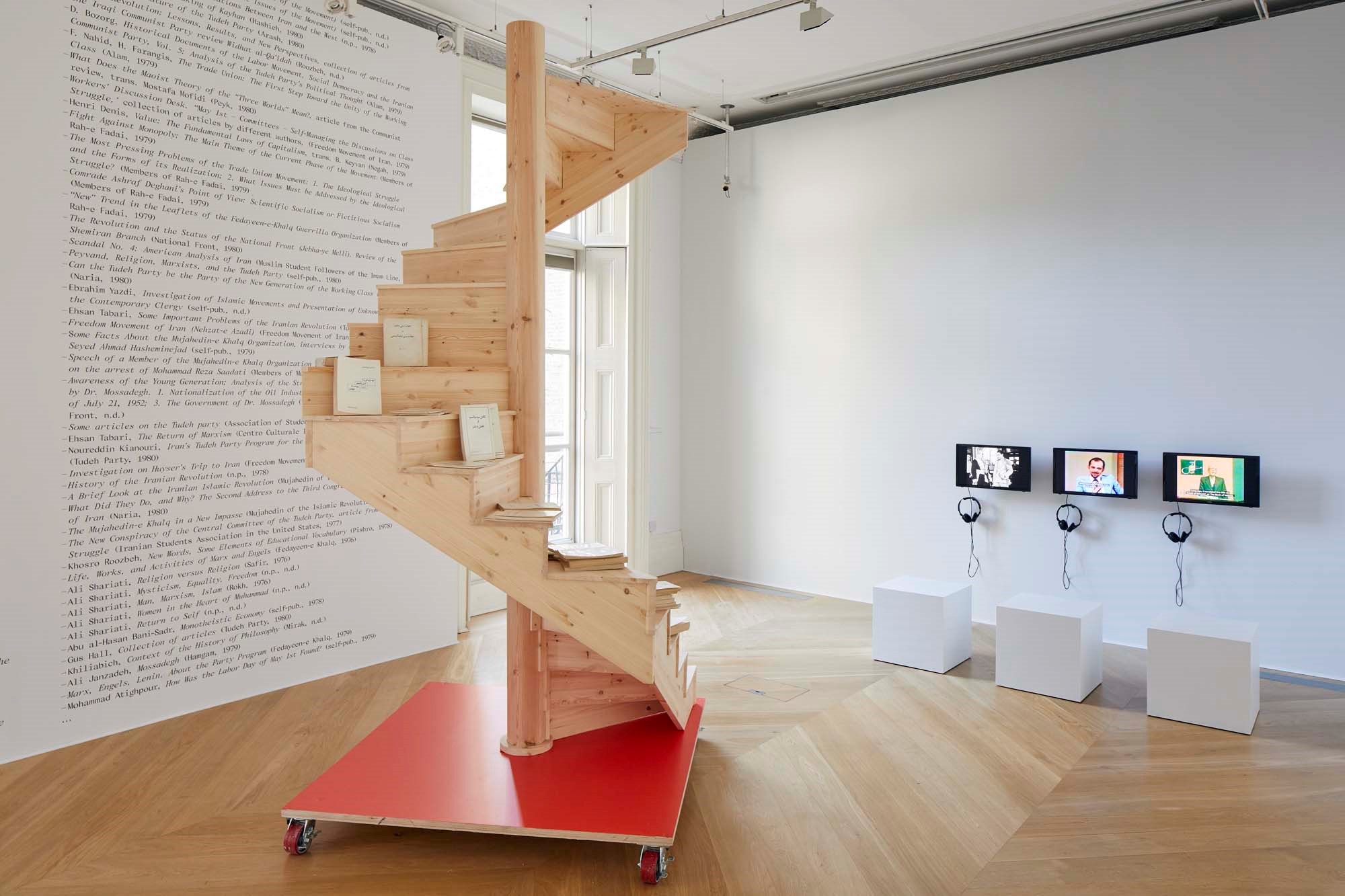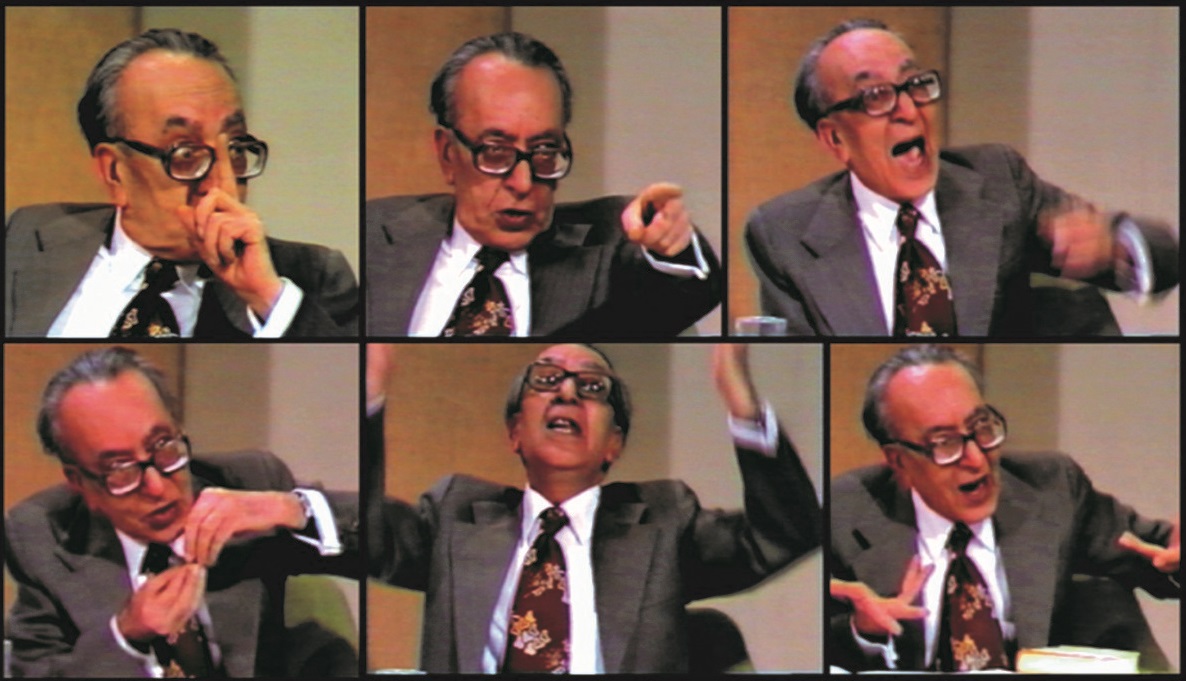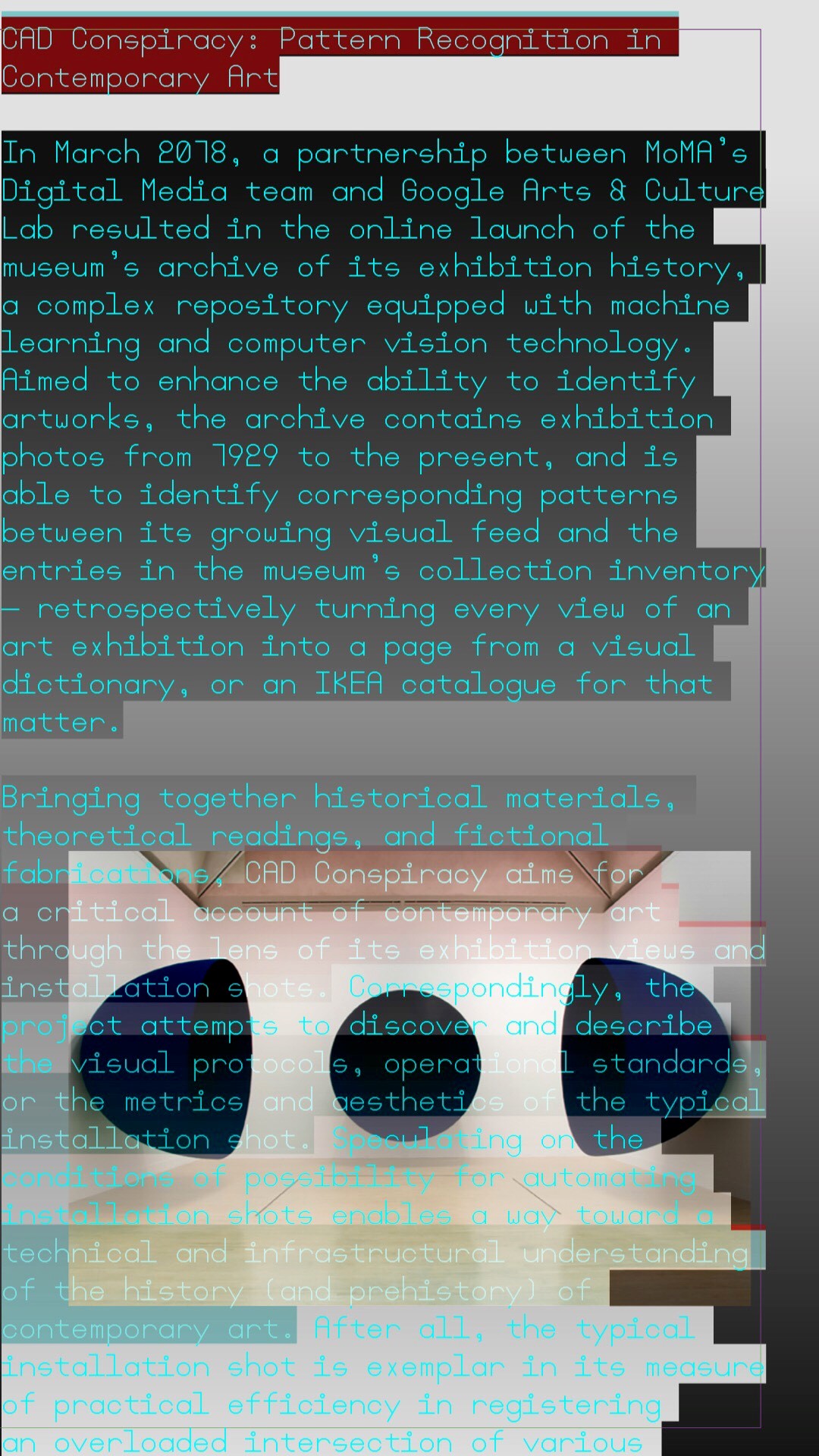Iranian artists revisit their relationship to a contested past
London's Mosaic Rooms showcases the work of Iran’s current generation of artists and writers

Visitors watch The Fabulous Life and Thought of Ahmad Fardid (2015), a film by Hamed Yousefi with Ali Miresepassi, at the Mosaic Rooms (Courtesy Mosaic Rooms. Photo by Andy Stagg)
27 February 2019 10:12 UTC |
This month marks 40 years since the Iranian revolution, an anniversary which has prompted many to turn their attention to Iran and discuss historical events and current realities.
Spanning over two floors of London gallery The Mosaic Rooms, When Legacies Become Debts is a group exhibition of contemporary Iranian artists revisiting their relationships to a recent, tumultuous past.
“The exhibition is about the personal bonds between two generations of artists and writers, and coming to terms with the desirable, but also confusing and problematic legacies of a generation who were involved in the Iranian revolution in 1979,” says Iran-based curator Azar Mahmoudian, who is an independent arts educator in Tehran.
The older generation of artists were “situated in a network of other struggles happening at the time, from independence movements to struggles against colonialism, gender inequalities and racism," she adds.
"It is an attempt to understand how we ended up in the current state of culture in the country, while refraining from producing an isolated narrative, and go beyond the 'Iranian–ness' of this situation."
Each from their own unique perspectives, the younger artists reflect on the cultural legacy they have inherited.
'The Euphoric Years': 1979 - 1983
Artist Hannah Darabi was born in 1981, a few short years following the 1979 revolution and in the midst of the Iran-Iraq war.
Darabi's work, Enghelab Street, a Revolution Through Books: Iran 1979-1983 revisits Iranian propaganda works published throughout these years, offering a unique insight into photographic production in Iran during this period. Her photo book of the same title will be released during the exhibition.

Darabi tells Middle East Eye how the time period in question was particularly euphoric for those in her parents’ generation who lived through it.
“There is this moment after the revolution, maybe eight or nine months, which people call the spring of liberty. It was a moment where freedom of speech in Iranian society flourished,’ she says from Paris via Whatsapp.
Fragmented histories
Her own experience of these events was constructed largely in fragments.
“Once I had this story taught by school; another time by my family, or friends, or parents of friends. There is never one story of the revolution,” remarks Darabi.
'There is never one story of the revolution'- Hannah Darabi, artist
"As I’m an artist and not a historian, it was important for me to have an artistic comment on this collection and for me it is telling the story of the revolution, which I receive in fragments," she adds.
"I think what’s important in this work is to say that this story is very fragmented and I don’t want to replace it with another story, so that’s why you see these pictures, in dialogue with each other, but also there is a distance between them, we understand that there are some empty spaces, some points that are lost or hidden or not very simply understood."
Works by Ronak Moshtaghi and Hamed Yousefi also work in conversation with Darabi’s work in illuminating diverse histories and narratives of the time.

The White Cover Books , reflected in Ronak Moshtagi and Darabi's work, are distinguishable by their plain white covers and bold black letterpress titles. These pirated books were published by the thousands by various political groups and sold in an underground manner on the streets.
Similarly, Hamed Yousefi’s documentary The Fabulous thought of Ahmad Fardid (2015) is a filmic exploration of the legacy of Iranian philosopher Ahmad Fardid (1910-1993).
Fardid, a professor of philosophy at the University of Tehran in the 1940s, considered himself an intellectual force against the rising Western influence in Iran at the time. He is best known for coining the term Gharbzadegi or "Westoxification", used to refer to the loss of Iranian cultural identity through the adoption of Western ideals and frameworks.

Through his documentary, Yousefi presents a comprehensive intellectual history of modern Iran from the constitutional revolution in 1906 to the post-1979 revolution period, through a figure who remains largely absent from discourses on the rise of political Islam.
The works on display bind together to produce a very rich yet fragmented account of what was happening in Iran at this momentous time.
Art from afar
Newly commissioned work by Mahan Moalemi and Bahar Noorizadeh, CAD Conspiracy (2019) is a three-channel video installation featuring a series of digitally manipulated installation shots of international contemporary art exhibitions.

Moalemi takes a keen interest in the work surrounding contemporary art which affects its delivery, what he refers to as "operative props" which include press releases, websites, installation shots and social media posts.
The focus on installation shots in CAD Conspiracypartly reflects the restricted access to international contemporary art exhibitions in Iran (and other countries), a situation which has led people to experience artworks online through installation shots.
Travel is becoming harder for the majority of Iranians, a problem exacerbated by the worsening economic situation in the country and the increasingly stringent immigration policies in the West.
Moalemi himself has been denied a visa from the UK to be present for the exhibition of his own work in London at this time.
Diaspora and the transnational
Bahar Noorizadeh left Iran at the age of 19, and she has since lived and worked in Canada, the United States and Beirut before moving to London where she is currently based to pursue her PhD at Goldsmiths.
Despite this transnational aspect to her identity and the geographical distance from Iran, she is extremely cautious of her positioning as an artist in the Iranian diaspora and the weight that this carries.
“I’m always conscious not to be that kind of fetishised Iranian artist outside of Iran because there is a currency that comes with that which I don’t feel I should be attached to,” she says.
Similarly, she is keen to convey the diversity of experiences and sentiment amongst young Iranians in the country today.
"It’s easy to imagine this total darkness of the situation there but I know a lot of people who do not want to leave, not even in a sacrificial way, but they actually think there are opportunities they have there that they won’t have in any other places."
* When Legacies Become Debts continues until 30 March at The Mosaic Rooms. The free exhibition is hosting a series of lecture style conversations with the artists which will unfold during the exhibition. Contributors include Heytham al-Wardani, Catherine David, Sumaya Kassamali and Sam Khatib among others.
https://www.middleeasteye.net/discover/iranian-artists-revisit-their-relationship-contested-past

0 Comments:
Post a Comment
Subscribe to Post Comments [Atom]
<< Home